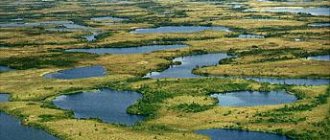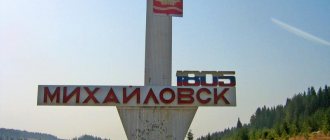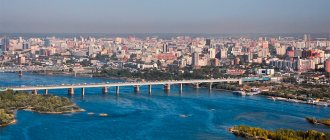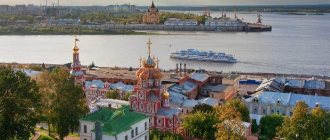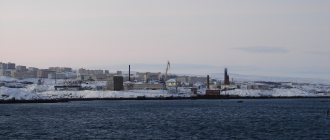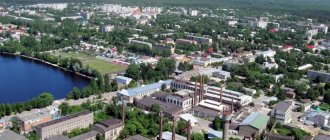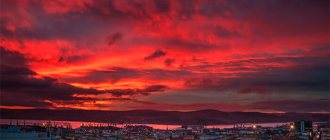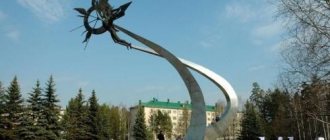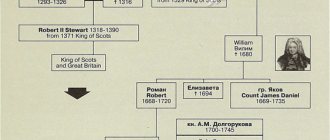This city is located in the southernmost part of the Altai Territory. Almost on the border with Kazakhstan. Slavgorod is separated from it by 100 kilometers of endless and seemingly lifeless steppe.
By the way, I don’t understand at all why these lands are not used in any way. In general, most of the land near Slavgorod is not planted with anything at all. And these are very fertile places. Almost the entire territory of the Altai Territory is fertile soil. Such soils, in addition to the Altai Territory, are also found in the Baltic states. But we got distracted.
Strange town
For decades, the Slavgorod district existed in the Altai Territory, but in 2011, by decision of the authorities, it was transformed - and the territory is over 2 thousand square meters. kilometers with two dozen villages and a population of almost 40 thousand began to be called an urban district.
Now Slavgorod is ready to be transformed into a municipal district - a relatively new form of administrative-territorial division, which involves the elimination of government bodies in villages and the management of the territory by one administration - the district.
Slavgorod, which includes settlements, according to the new legislation, actually has no options left - it is obliged to become a district by 2025, the regional government previously said.
But this could be beneficial for the city - budgetary security will increase, says Vice-Speaker of the AKZS Denis Goloborodko. A municipal district, unlike a city district, involves significantly larger deductions from personal income tax and a simplified taxation system to the local budget. If in the city this is 20% and 50%, respectively, of the volume of these types of taxes collected in the region, then in the district it is 60% and 75%.
The initiator of the adoption of legislative changes was the city district itself, Goloborodko told Tolk.
Slavgorod
In the central part of Slavgorod there are monuments of architecture and urban planning of the pre-revolutionary period (buildings of a museum, civil registry office, shops), 1920–1930s (buildings of two buildings of a pedagogical college, a former state bank, main post office, veterinary hospital) and modern (buildings of a savings bank, border control department , city administration, hotel, trading house "Iskra"). In this part of the city there is a Memorial of Glory to the soldiers of Slavgorod who died during the Great Patriotic War, a renewed monument to soldiers who took part in the fighting in Afghanistan and Chechnya, a monument-bust to P. A. Stolypin, a memorial sign in commemoration of the 100th anniversary of the founding of Slavgorod.
The station area of the city includes pre-revolutionary and pre-war engineering structures of the railway station, buildings from the 1920s (agricultural technical school, administrative building of the KPO plant, former railway school), as well as a modern railway station and other buildings. On the station square there is a monument to V.I. Lenin, and on the platform there is a memorial sign in honor of the 312th Smolensk and 380th Oryol Red Banners, the Orders of Suvorov and Kutuzov rifle divisions formed in 1941 in Slavgorod, and a steam locomotive as the main locomotive railway lines.
Base of the Regional Consumer Union, Slavgorod, st. V. I. Lenina, 1.
The building was built in 1928 and is located near the railway station. It is two-story, brick, L-shaped in plan, made in constructivist forms. Architectural monument of the first five-year plan.
Administrative building, Slavgorod, st. V. I. Lenina, 145.
The building was built in 1930 and is located in the city center. Two-story, brick, rectangular in plan; elements of the original interior have been preserved. An architectural monument of the first five-year plan with elements of constructivism.
Administrative building, Slavgorod, st. V. I. Lenina, 24.
The building was built in the mid-1910s and is located near the railway station. Two-story, red brick, rectangular in plan. An architectural monument of the early 20th century. in eclectic forms, one of the first brick buildings in Slavgorod.
Pedagogical College, Slavgorod, st. A. V. Lunacharsky, 146.
The building was built in 1926 and is located in the historical part of the city. Two-story, brick, with a semi-basement in the basement. An example of an educational building from the early 20th century, an architectural monument with elements of constructivism. There is a memorial plaque on the facade of the building: “In this building from June 1941 to March 1943 there was a hospital for soldiers of the Great Patriotic War.”
Bank, Slavgorod, st. Volodarsky, 145.
The building was built in 1930 and is located in the city center. Two-story, brick, L-shaped in plan with a cut off southwestern corner with an entrance node. Elements of the original interior have been preserved. An architectural monument of the first five-year plan in the forms of constructivism.
Communications office, Slavgorod, st. K. Marx, 145.
The building was built in 1931 and is located in the city center. Two-story, brick, plastered, L-shaped in plan. An architectural monument of the first five-year plan with elements of constructivism.
Veterinary hospital, Slavgorod, st. Pervomayskaya, 145.
The building was built in 1929. Standing alone in the city center, it is a one-story, brick building with a complex plan and has a horizontally deployed asymmetrical compositional structure. The eastern part of the southern facade is crowned by an attic with an image of the USSR coat of arms in the panel and the inscription “USSR”. Architectural monument of the first five-year plan.
Memorial of Glory, Slavgorod, city park, st. V.I. Lenina, 167/2. The memorial complex is located in the southern part of the city park. Includes a stele, a wall with the names of the dead, ten busts of Heroes of the Soviet Union, two pylons with memorial plaques. The authors of the monument are sculptor K. G. Chumichev and architect V. M. Mikhailov. The monument was opened on May 9, 1977.
Monument to fellow countrymen who died in local wars, Slavgorod, city park, st. V.I. Lenina, 167/3.
The monument was built on the initiative of the Slavgorod administration in 1995 from pure Sayanogorsk marble and installed in the southern part of the city park. It consists of two steps leading to a rectangular platform on which three cabinets are installed at equal distances from each other. In the center of the cabinet there is a rectangular marble slab with a truncated upper left corner. On the plate there is an inscription:
“I bow to you,
Dear fellow countrymen,
Because you fought heroically,
For walking through thousands of deaths,
For never forgetting
About home and about your homeland."
Monument to V.I. Lenin, Slavgorod, 1st Vokzalnaya street, 26a.
The monument was built in 1968 in honor of the founder of the CPSU and the Soviet state. On the pedestal there is a full-length sculpture of V.I. Lenin, in his right hand raised up is his cap, and his left hand is in his coat pocket.
Monument to P. A. Stolypin.
Monument to P. A. Stolypin
In 1910, P. A. Stolypin and the head of the resettlement department, Krivoshein, visited Altai. They visited many villages of Kulunda, Semipalatinsk district. During a trip to the steppe Altai, Stolypin gave instructions to found a settlement and build a railway there to ensure the export of grain from the surrounding areas. Thanks to this visit, the village of Slavgorodskoye soon received the status of a city, the construction of the Altai Railway was accelerated, and lending to settlers was improved.
The monument to the founder of Slavgorod P. A. Stolypin was unveiled on August 20, 2010 in the central square of the city. It is a bust on a high pedestal, on which is engraved the inscription: “To Peter Arkadyevich Stolypin - the founder of Slavgorod.” The three-meter-tall red marble monument was created by the famous Altai sculptor Nikolai Zvonkov. The monument was solemnly opened by participants in the scientific conference “The Role of P. A. Stolypin’s Agrarian Reforms in the Development of Siberia and the Far East,” which began its work on August 19, 2010 in Barnaul. Sectional sessions were held in the German National and Klyuchevsky districts and Slavgorod.
Local Lore Museum of Slavgorod (K. Liebknecht, 143).
Founded in 1958 by V. G. Zhemerov. For many years, the museum room was located in the building of the city House of Culture. On October 6, 1978, the collections were housed in the building of the trading office of the merchant Selyutin, built in the early 20th century.
Currently, the museum's holdings include more than 23,000 exhibits that reflect the history of the city and region. The museum's ethnographic collection includes household items and clothing of settlers. Visitors are presented with unique collections of cameras and movie cameras, samovars, musical instruments, and numismatics. Letters from the front, awards, documents tell about the participation of Slavgorod residents in the Great Patriotic War. The Nature Department introduces visitors to the flora and fauna of the region. In 2005, the exhibition was supplemented by the archeology department. Since May 1997, there has been an exhibition hall where artists from the city, region and region present their work. Exhibitions of arts and crafts and a photo competition “The City Where I Live” are held annually. More than 15,000 people visit the museum every year.
Much attention is paid to military-patriotic, moral and aesthetic education. Thematic lessons, conversations, lectures, lessons of courage, meetings with veterans of the Great Patriotic War, veterans of local wars, and home front workers are held for school students. Research work is underway. The museum cooperates with various club associations.
In 2006, the museum won the competition for the best exhibition project of the regional festival “Museum Crossroads”. In 2010, as part of the regional museum ethnofestival “We live in Altai,” the museum participated in the competition of cultural and educational projects “Altai - at the crossroads of cultures,” in which it defended the project “Tula samovars on Slavgorod land.”
City House of Culture (K. Marx, 167).
The House of Culture of Slavgorod is the main center of culture and leisure for different age and social categories of the city's population. On its basis there are two groups that have the title “folk”, these are the song ensemble “Slavenka” and the municipal orchestra of brass and jazz music. There are also a choir of war and labor veterans, a club “Veteran”, a children’s club “Merry Kaleidoscope”, an oriental dance studio “Eshta”, a vocal group “Kalinushka”, a trio “Harmony”, etc.
The auditorium of the State House of Culture has a capacity of 350 seats. The work of the creative team of the House of Culture is aimed at preparing and holding theatrical performances, city, regional festivals and competitions, calendar holidays, recreational evenings, educational, entertainment and competitive game programs for children and adults.
The city has religious sites: the Cathedral Muslim Mosque, the Church of St. Nicholas, the Church of Alexander Nevsky, the Temple in honor of the Supreme Apostles Peter and Paul, the Catholic Church of the Assumption of the Blessed Virgin Mary.
The Aquaterrarium mini-zoo has been operating since 1999. In it you can see specimens of rare fish, reptiles, and animals.
Lake Bolshoye Yarovoye is an endorheic bitter-salty lake in the western part of the Kulundinskaya Plain, 6 km southwest of Slavgorod. The lake is famous for the healing properties of its bitter-salty mineralized water and silt mud.
Kozhevnikov Readings
Kozhevnikov's local history literary readings are associated with the name of the outstanding writer of Siberia Savva Elizarovich Kozhevnikov (September 14, 1903, the village of Krivinskoye, Tomsk province - October 23, 1962, Yalta). In the early 1930s. lived in Slavgorod and worked as editor of the Slavgorod district newspaper.
Publicist, literary critic, prose writer, essayist Savva Kozhevnikov spent his entire life in Siberia, traveled around it in different directions and enthusiastically sang his praises in articles, stories, and essays. They contain a lot of accurately conveyed characteristic facts of reality, a lot of history. Savva Elizarovich was and remains a recognized expert on Siberia, its past and present, its countless riches and wonderful people. This is the essence of the creative character of a writer.
One of the constant themes in the work of Savva Kozhevnikov was Altai. The participants in the readings are continuers of the work of S. E. Kozhevnikov. They painstakingly study, analyze, and summarize materials related to the distant and near history of the city of Slavgorod.
Kozhevnikov Readings 2013
Kozhevnikov Readings 2007–2008
Gribanov readings
Gribanov readings are held in honor of a member of the Union of Writers of the USSR, candidate of historical sciences, honored worker of culture of the Russian Federation, critic, literary critic, prose writer, translator Boris Timofeevich Gribanov . Readings are held in the writer’s homeland, in Slavgorod.
The initiator of the readings is the administration of Slavgorod, deputy head of the administration P. E. Fitz.
The first Gribanov readings took place on November 16, 2006 - on the birthday of B. T. Gribanov. The topic of the readings was the work of E. Hemingway, whose works were translated by B. T. Gribanov.
Traditionally, readings are prepared by employees of the city’s central library. The name of Boris Gribanov is widely known in literary circles. It was he who, as a translator, first introduced Russian readers to many treasures of foreign literature.
Among the participants in the readings are representatives of the Slavgorod administration, teachers and students of the pedagogical college, literature teachers, and representatives of the local intelligentsia.
Which areas decided to become districts
In the Altai Territory, the pioneer was the Zalesovsky district, which underwent the transformation procedure in 2022 and will begin operating as a district on January 1.
The main discussions about the advantages and disadvantages of the new form took place in connection with this area. Among the advantages were clearer controllability, concentration of responsibility in one hand, savings in budgetary funds on the administrative apparatus, and growth in budget revenues. Among the disadvantages are the possible loss of communication with the population, the remoteness of a number of villages from the decision-making center, and others.
On December 24, it became known that they also want to become a district in the Suetsky district, where only 4.5 thousand people live.
Initially, it was also reported that discussions on the subject of reforms took place in the Charysh and Petropavlovsk districts, but were not continued due to the ambiguous reaction of deputies of village councils, whose consent to the reform is mandatory.
At the same time, the regional authorities have repeatedly repeated that they are not going to forcefully impose a new form of organization of power on the ground, since it may not be effective everywhere, but they are providing such an opportunity.
December 27, 13:45
Economy
In Slavgorod there are OJSC Slavgorod Radio Equipment Plant, LLC Slavgorod Plant KPO (forging and pressing equipment plant) and OJSC Slavgorod Dairy Plant. Previously, there were many industrial enterprises in the city, but many of them stopped working completely, and some were converted - for example, a garment factory was converted into a municipal market. But the Slavgorod meat processing plant does not work at all. But trade is developing by leaps and bounds: last year the Maria-Ra shopping complex and about a dozen other small retail outlets were built.
There is almost no construction of new houses in the city; only old housing is being renovated; many residential buildings are considered to be in disrepair.
Sport
Various sports are actively developed in Slavgorod: hockey, sambo, kickboxing, boxing, football, basketball. The youth teams of the Crystal hockey club have repeatedly taken prizes at the regional level, and in 2000 the Crystal-85 team became the champion of Russia, winning the all-Russian final tournament “Golden Puck” among hockey players born in 1985-1986, held in Yaroslavl (team coach - Anatoly Pinigin).
Sambo wrestlers from Slavgorod (coach Valery Dmitrievich Dmitriev) regularly emerge victorious in regional tournaments and zonal competitions. The guys also participate in the Russian Championship and various international tournaments. The Dolphin swimming pool has sections where schoolchildren and students conduct training. Swimmers take part in regional competitions, as well as in competitions held in other cities of Russia. The military-patriotic club “Paratrooper” was created in 1988, preparing children for military service. The Paratrooper Club has been ranked as the best military-patriotic club in the Altai Territory for 10 years in a row. City stadium "Crystal" is located in the center of Slavgorod. In addition to the football field, the stadium has a large gym and an indoor hockey stadium, which, thanks to the cooling system, functions on hot summer days.
Population
| Population | |||||||||
| 1931 | 1959 | 1967 | 1970 | 1979 | 1989 | 1992 | 1996 | 1998 | 2000 |
| 15 900 | ↗38 413 | ↘31 000 | ↗32 908 | ↘32 135 | ↗34 864 | ↗35 000 | ↘34 100 | →34 100 | ↘33 800 |
| 2001 | 2003 | 2005 | 2006 | 2007 | 2008 | 2010 | 2011 | 2012 | 2013 |
| ↘33 600 | ↗34 300 | ↗34 800 | →34 800 | →34 800 | →34 800 | ↘32 389 | ↗32 415 | ↘32 337 | ↘31 707 |
| 2014 | 2015 | ||||||||
| ↘31 006 | ↘30 591 | ||||||||
Television, print and radio broadcasting
| This section is missing references to information sources. Information must be verifiable, otherwise it may be questioned and deleted. You may edit this article to include links to authoritative sources. This mark was set on August 14, 2013 . |
A television
- 1 TVK - NTV
- 7 TVK - Channel One
- 23 TVK - TNT / TRUST-REGION
- 26 TVK - STS / TV Steppe
- 29 TVK - The first digital television multiplex
- 33 TVK - Russia 1 / State Television and Radio Broadcasting Company "Altai"
- 38 TVK - REN-TV / Channel 38 - Trust
- 47 TVK - Second digital television multiplex
- 50 TVK - Katun-24
- 56 TVK - St. Petersburg - Channel 5
Printed publications:
- "Slavgorod news"
- Newspaper "Neighbors"
Broadcasting:
- 68.20 MHz - Radio Russia / State Television and Radio Broadcasting Company Altai
- 68.60 MHz – Auto radio Slavgorod
- 102.5 MHz – Russian Radio
- 103.1 MHz - Police Wave / Katun FM
- 104.3 MHz – Radio station “Radio”
- 105.8 MHz – Auto radio Slavgorod
Local government
| This section is missing references to information sources. Information must be verifiable, otherwise it may be questioned and deleted. You may edit this article to include links to authoritative sources. This mark was set on August 14, 2013 . |
The representative body of government is the city meeting of deputies, consisting of 21 people. Chairman of the city meeting of deputies (head of the city) A. M. Ushanev. The head of the city administration (city manager) is appointed by the city meeting of deputies. Since July 2012, the head of the city administration is V. A. Kintzel.
Links[edit]
Notes[edit]
- ^ abcde Law No. 28-ZS
- Official website of Slavgorod. General plan of the municipal formation of the city of Slavgorod, Altai Territory (extract) [ permanent dead link
], page 6 p. - ^ a b Federal State Statistics Service (2011). “All-Russian Population Census 2010. Volume 1" [All-Russian Population Census 2010, vol. 1]. All-Russian Population Census 2010 [All-Russian Population Census 2010]
. Federal State Statistics Service. - "26. The size of the permanent population of the Russian Federation by municipalities as of January 1, 2022". Federal State Statistics Service. Retrieved January 23, 2022.
- ^ abc Law No. 124-ZS
- ^ ab Law No. 116-ZS
- "On the Calculation of Time". Official Internet portal of legal information
. June 3, 2011. Retrieved January 19, 2022. - Post office. Information and computing center of OASU RPO. ( Post office
).
Search for postal service objects ( postal Search for objects
) (in Russian) - ↑
Federal State Statistics Service of Russia (May 21, 2004).
“The population of Russia, the constituent entities of the Russian Federation as part of federal districts, urban settlements, settlements, settlements of 3 thousand or more people” [Population of Russia, its federal districts, federal districts, districts, urban settlements, rural settlements - administrative centers and rural settlements with a population of more than 3,000 people] (XLS). All-Russian Population Census 2002
. - “All-Union Population Census of 1989. The current population of union and autonomous republics, autonomous regions and districts, territories, negative phenomena, urban settlements and rural district centers” [All-Union Population Census of 1989: current population of union and autonomous republics, Autonomous regions and districts , territories, regions, districts, urban settlements and villages performing the functions of district administrative centers. All-Union Population Census of 1989 [All-Union Population Census of 1989]
.
Institute of Demography of the National Research University: Higher School of Economics [Institute of Demography of the National Research University: Higher School of Economics]. 1989 - via Demoscope Weekly
.
